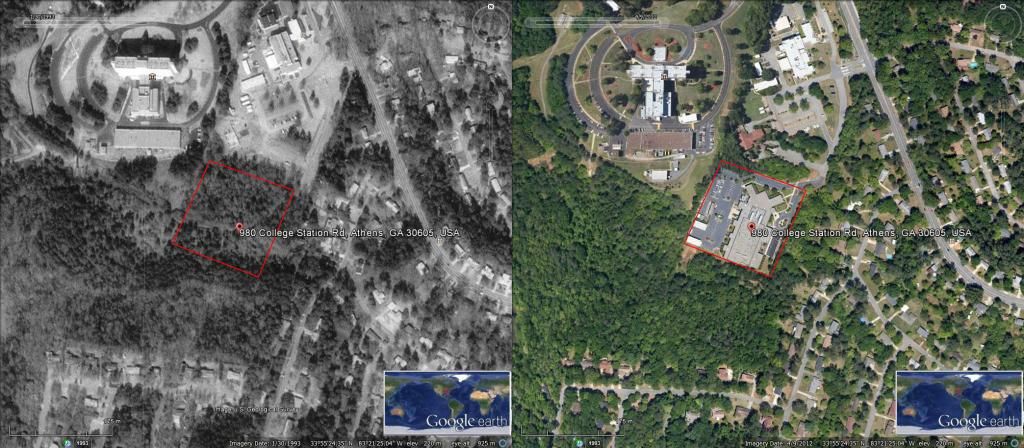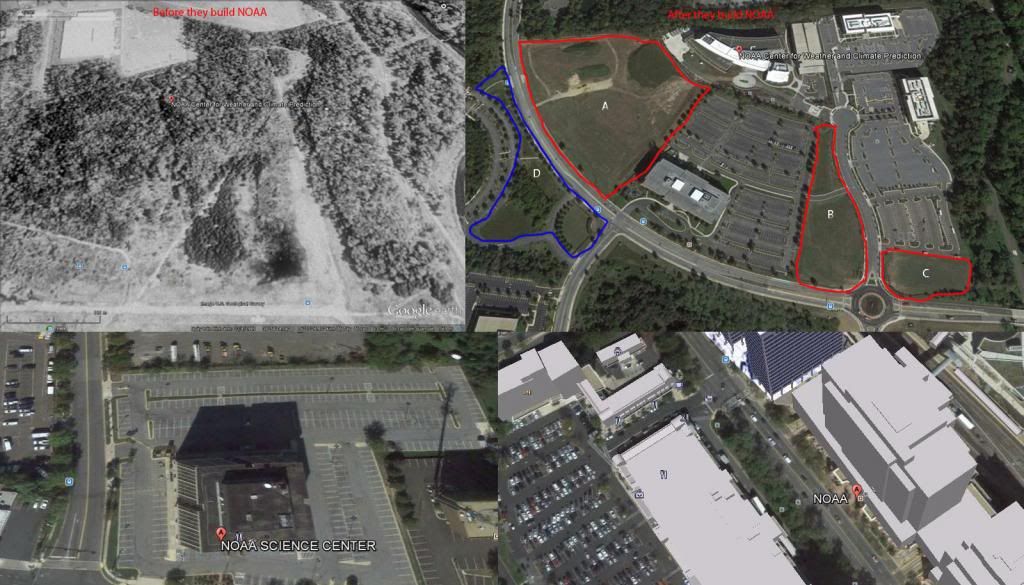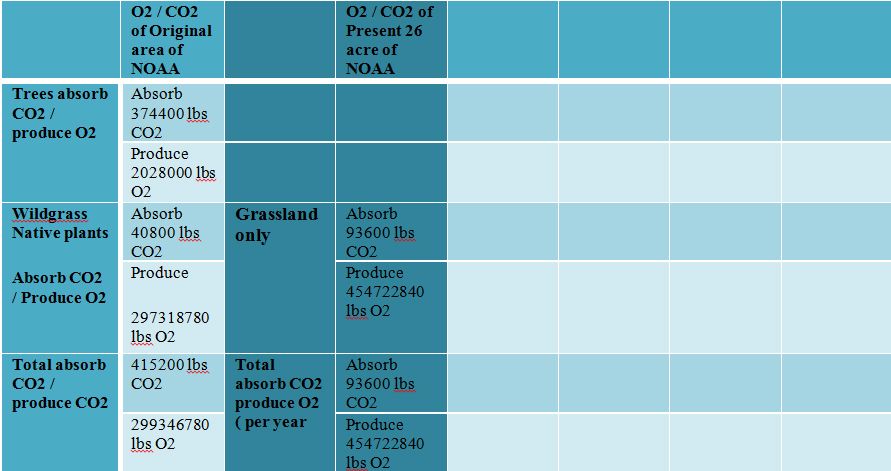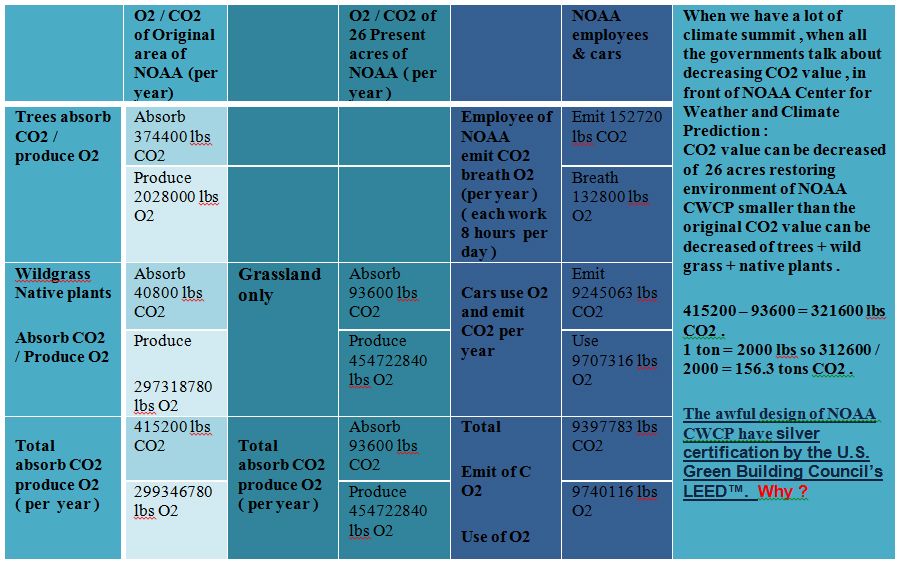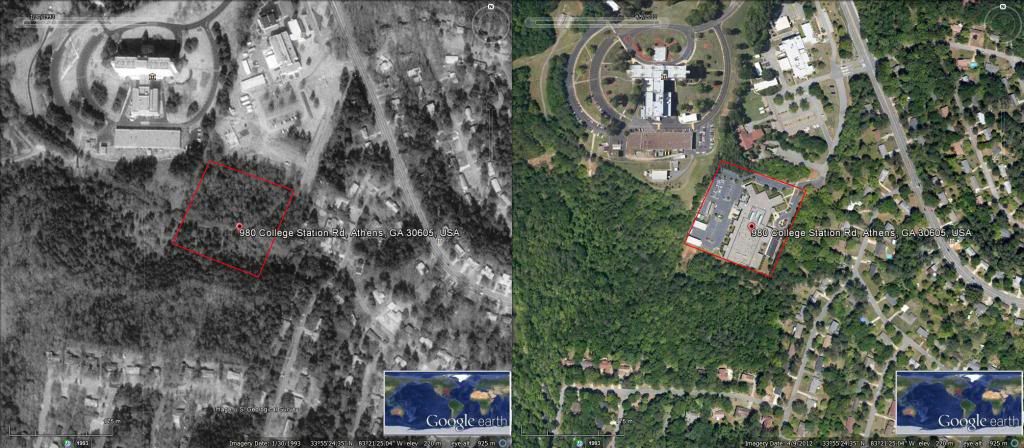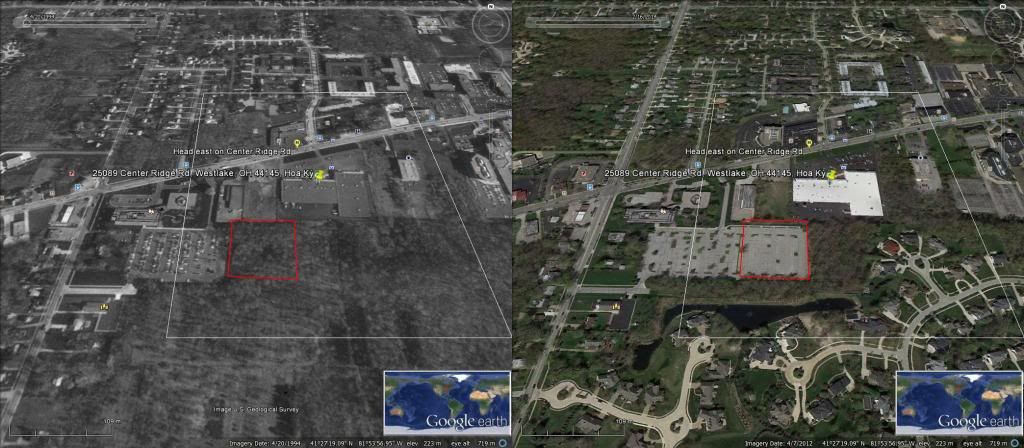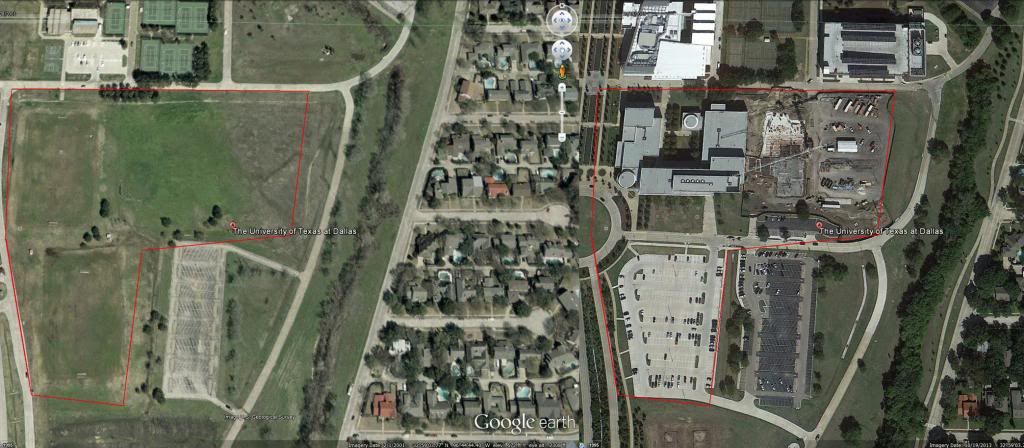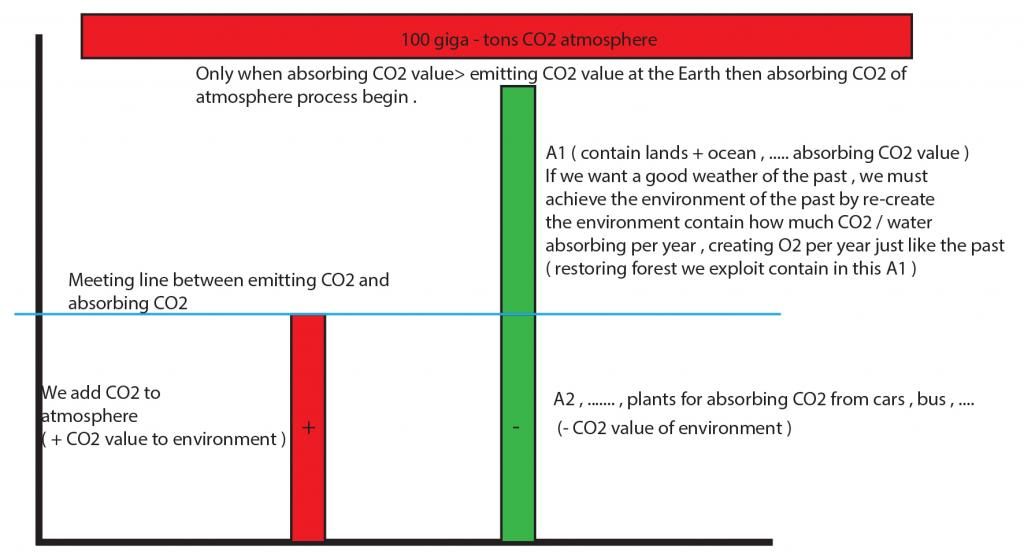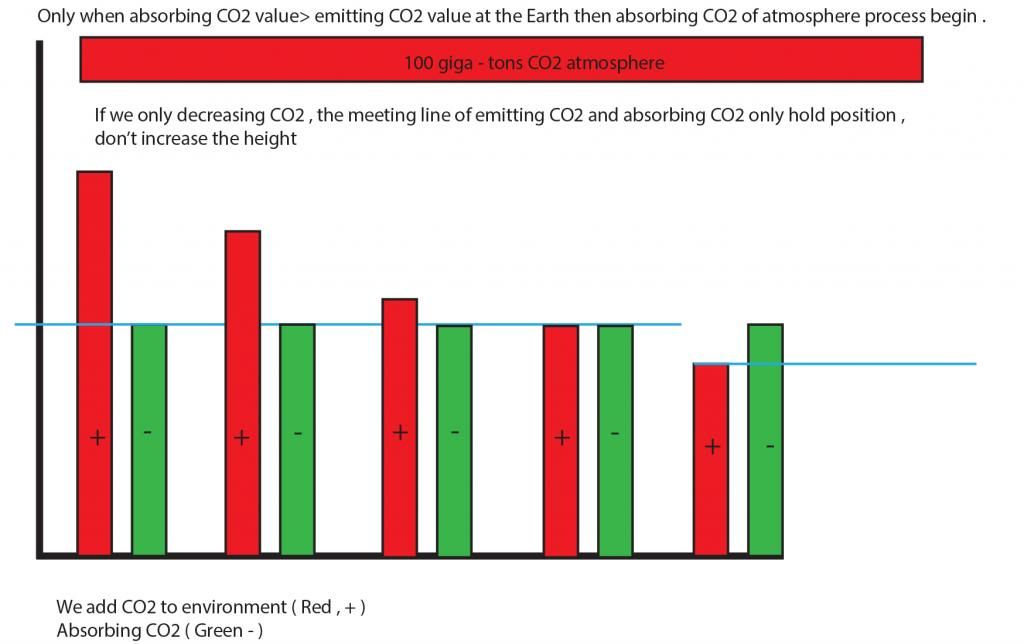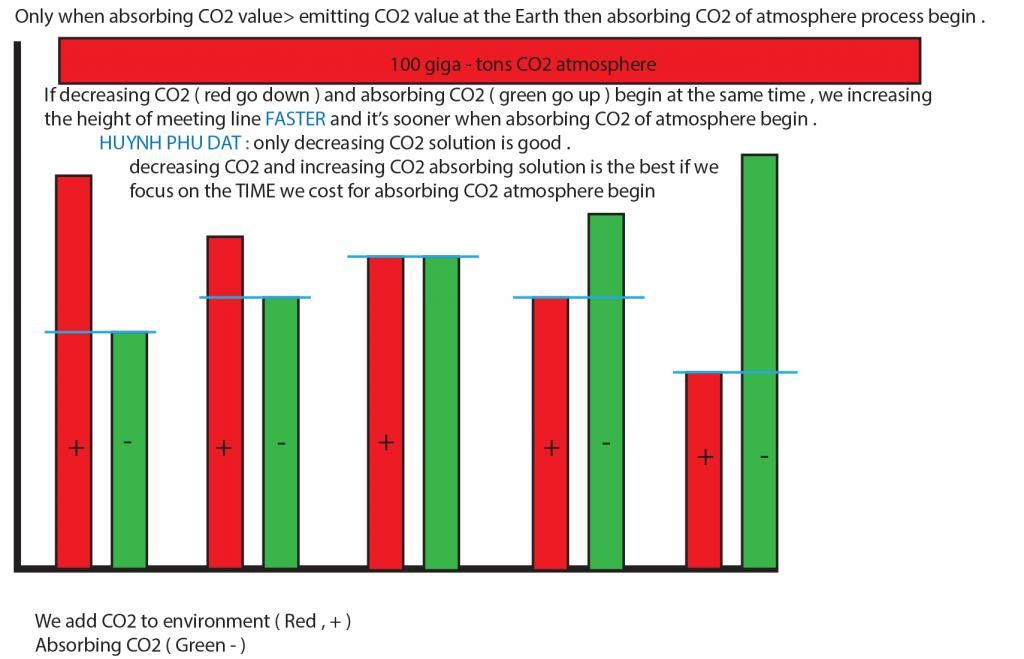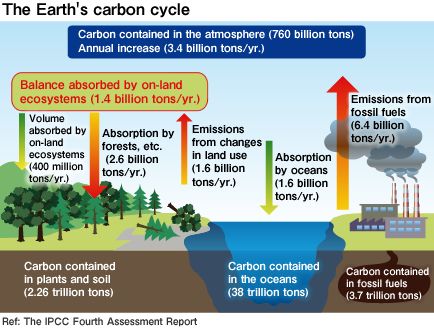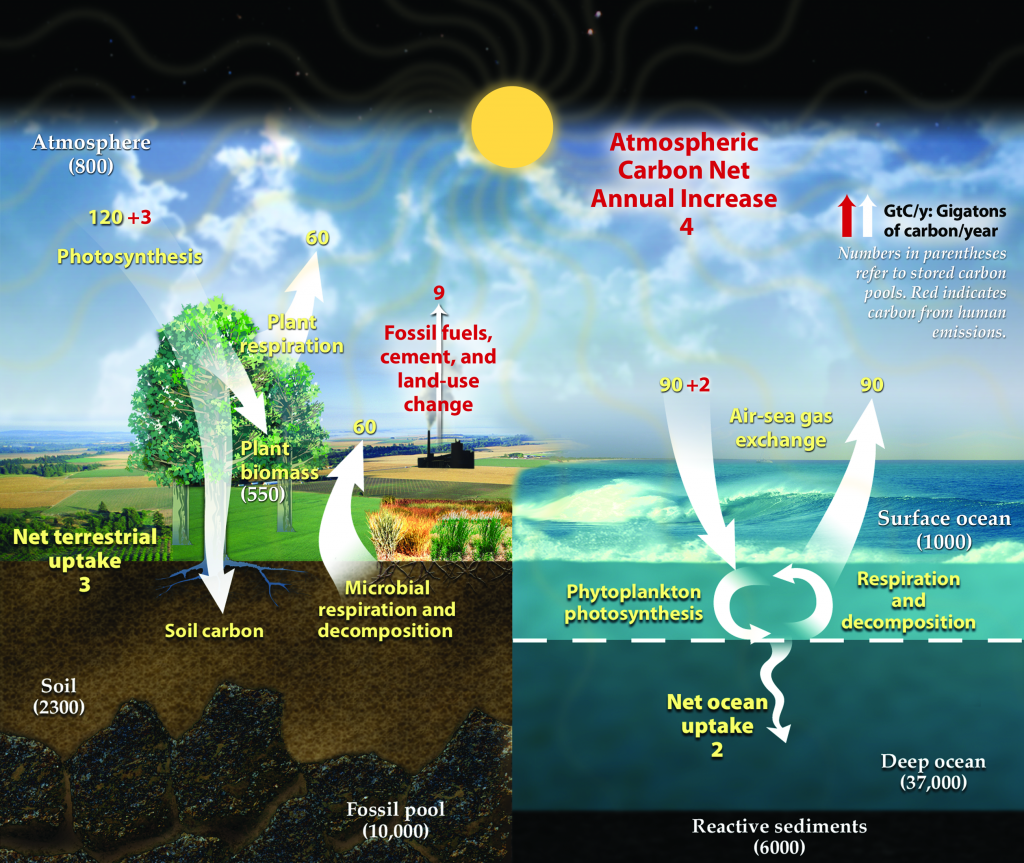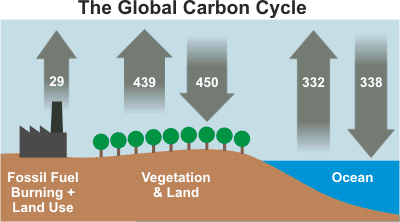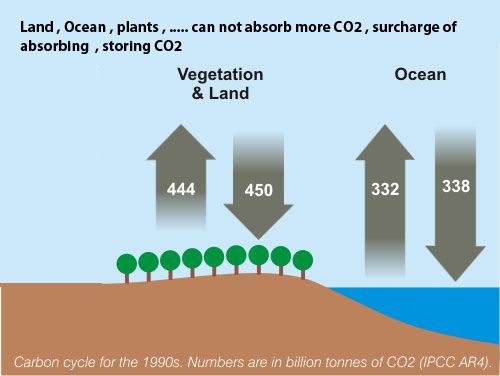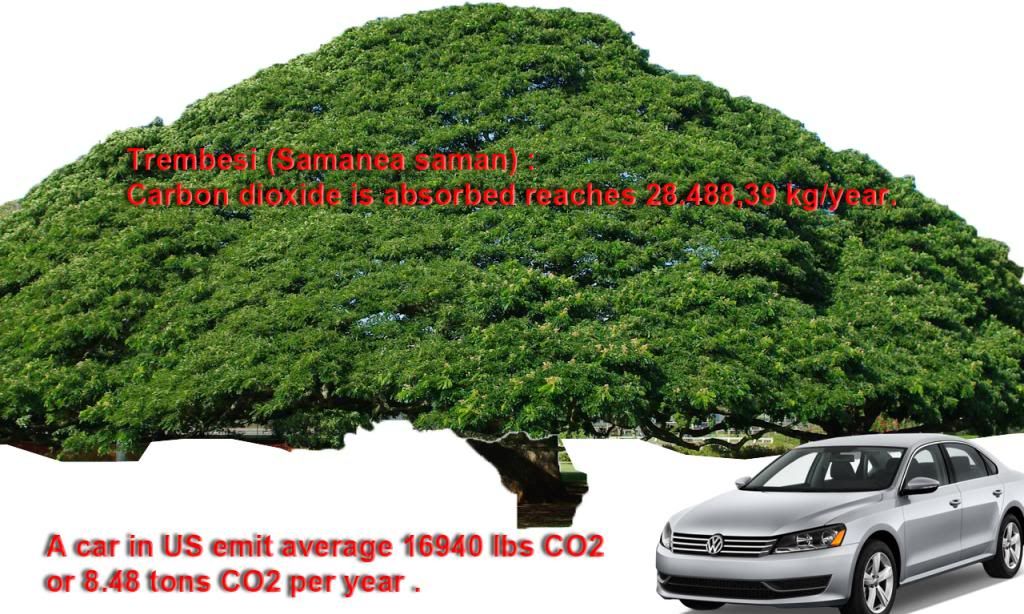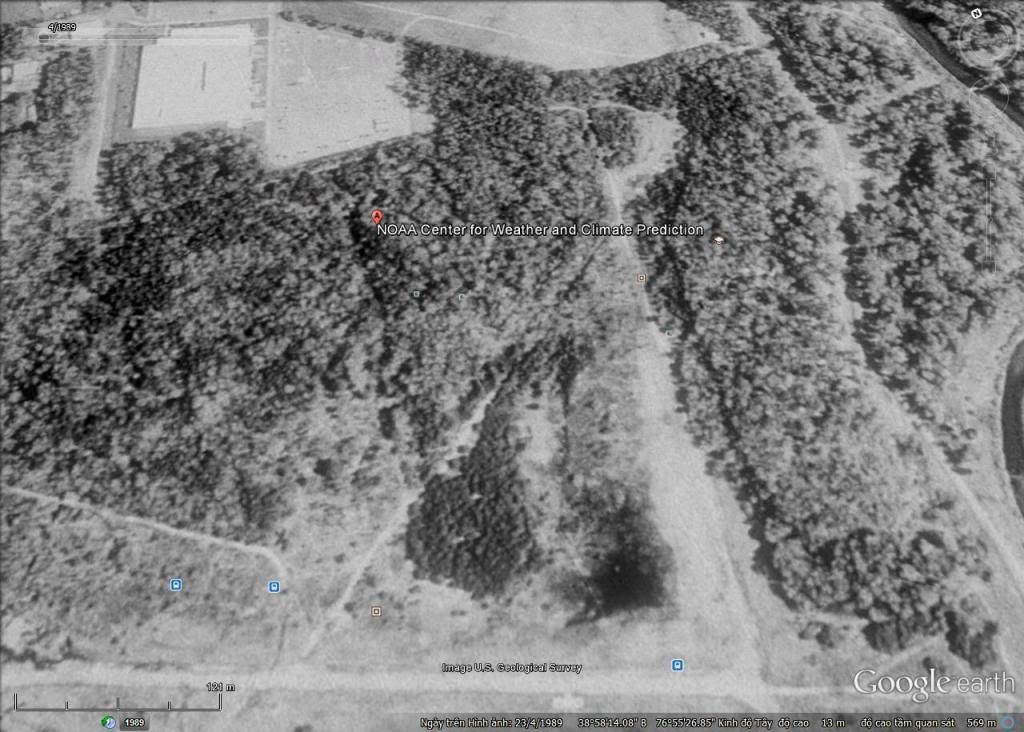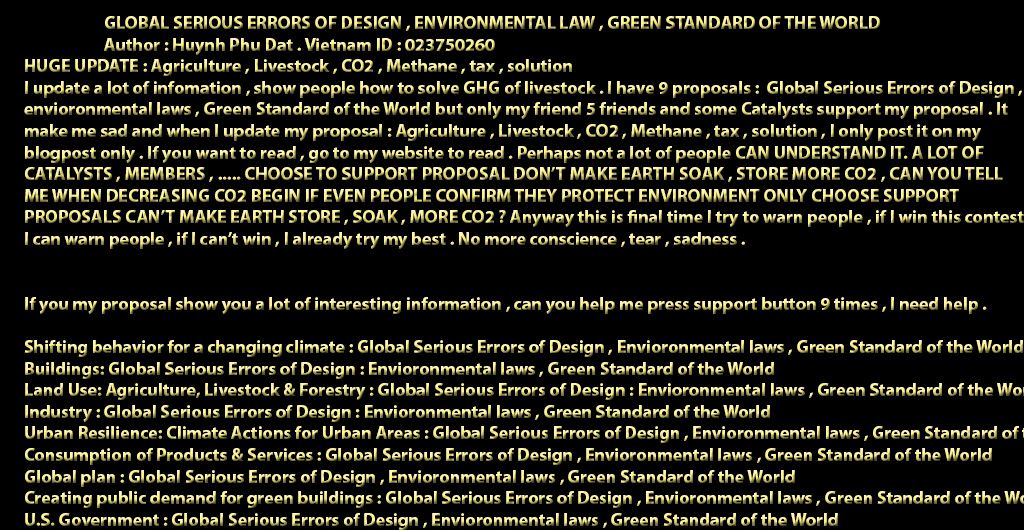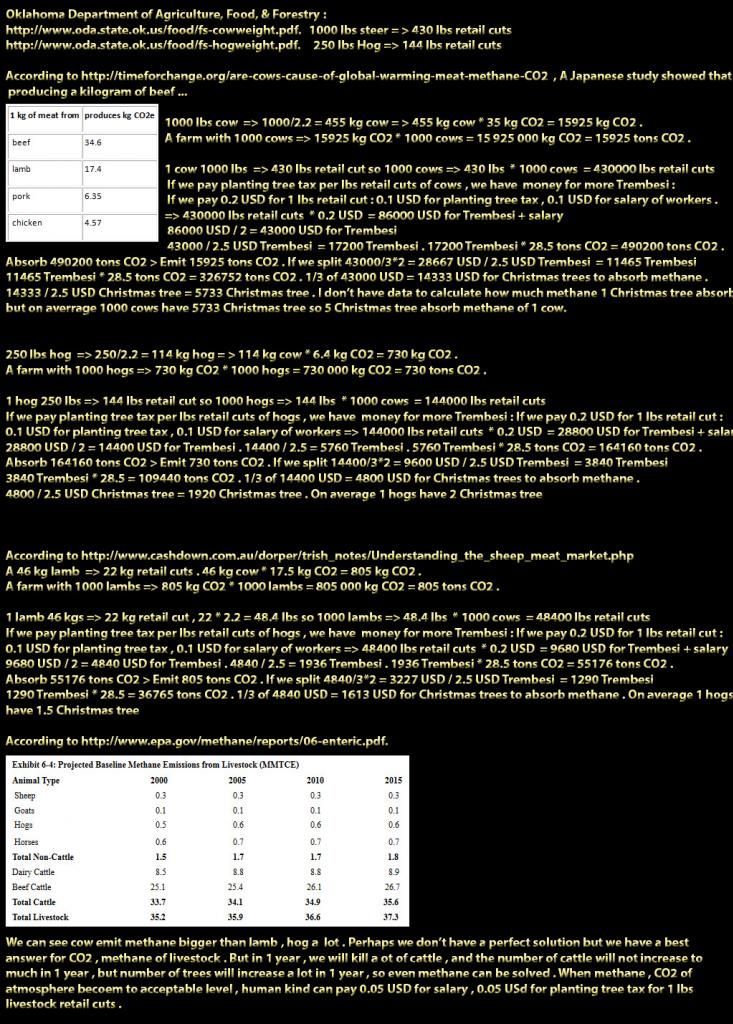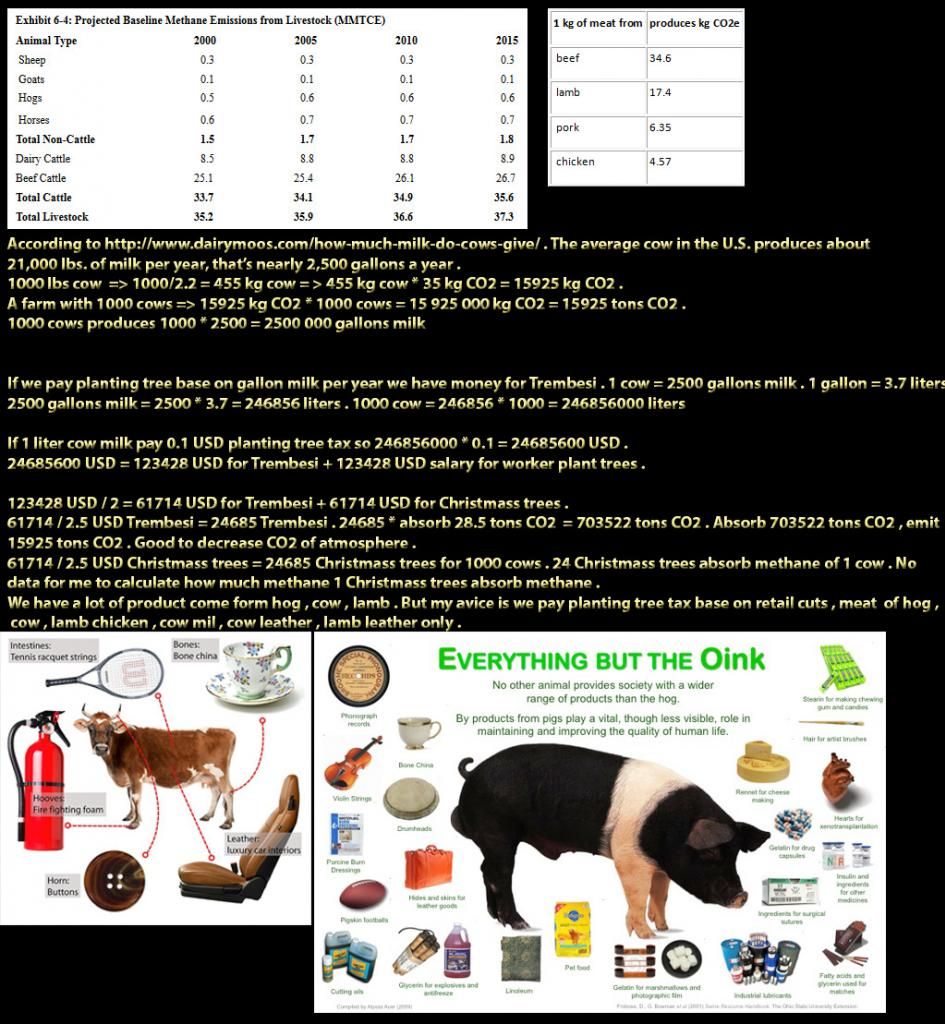Climate Change and Global Serious errors of Design
Abstract : Do we protect environment good or not ? Example
we design our city with 90% area is plants and 10% area is buildings . Is it
correct 100% ?No , it’s not correct . Example before we build constructions ,
the area which wild plants , trees absorb 1 million lbs CO2 , and then we build
some buildings , the area which trees , grassland only absorb 900 000 lbs CO2 .
So we damage environment , we lost 100 000 lbs CO2 should absorbed by trees ,
plants , right ? And our environmental law allow that , or legislator ,
environmental scientists absolutely don’t have knowledge about conservation of
absorbing CO2 , creating O2 , absorb water in urban design , ……. And in Climate
Change , it’s really not good , when environment which we restore absorb less
CO2 than environment of the past , right ? Scientist need to know about this problem . Do
we build our cities , towns without comparing value of absorbing CO2 , before
and after we build city , town …. 100% around the world ? Yes . Is that a global
serious errors of design , yes . All the scientific forum I posted my topic ,
they're all biology expert , physics expert , ...... but all of them almost
silent when read my topic, no one can confirm I was wrong .
I will analyze 1 best building and it’s environment before and after
they build the building : NOAA Center for Weather and Climate Prediction
, this building finish in 2009 with 50 acres – section and 26 acres for
grassland .
Google Earth image .
This is image of NOAA . Above are original place
of NOAA Center for Weather and Climate Prediction , before US build
NOAA Center for Weather and Climate Prediction, College Park, Maryland
and after they build the building . Sadly , the architecture don’t know
about the original O2/CO2 come from this area .
3 buildings ,
only 1 have a chance to restore the original environment but the
architecture don’t take this opportunity for a better environment , they
use this for worse environment . This things is a serious errors all
around this world when they choose grassland .
NOAA Center for
Weather and Climate Prediction have 800 employees include staff work
inside the building .“ More than 50 percent of the roof surface covered
with plants, including chive, sedum, and flowers for better insulation
and protection “ ( Credit : NOAA )
I use Google Earth for
measuring and I have 26 acres of grassland so I only analyze the 26
acres section to find out did US government protect the environment or
not
The original place ( A + B + C = 26 acres ) before US
government build are 26 acres of trees and wild grass area. With black
white image , I estimate 1 acre of tree have 300 mature trees and 2/3
area for grass .
"A single mature tree can absorb carbon dioxide
at a rate of 48 lbs per year- McAliney, Mike. Arguments for Land
Conservation: Documentation and Information Sources for Land Resources
Protection, Trust for Public Land, Sacramento, CA, December, 1993
On
average, one tree produces nearly 260 pounds of oxygen each year. Two
mature trees can provide enough oxygen for a family of four. Environment
Canada, Canada's national environmental agency
So 26 acres( A + B + C = 26 acres ) of trees with 300 trees per acre = 26 * 300 = 7800 trees .
In 1 year , 26 acres of trees absorb : 7800 *48 = 374400 lbs CO2 .
In 1 year , 26 acres of tree produce : 7800 * 260 = 2028000 lbs O2 .
In 1 year , 26 acres of trees absorb : 7800 *48 = 374400 lbs CO2 .
In 1 year , 26 acres of tree produce : 7800 * 260 = 2028000 lbs O2 .

Mature grasslands sequester 2400 - 3600 lbsCO2 per acre each year –
Technical Assessment of the Carbon Sequestration Potential of Managed
Turfgrass in the United State ,Dr . RanajitSahu , 2008 at the request of
the Outdoor Power Equipment Institute .
It is estimated that a
50 by 50 foot lawn (2,500 square feet), releases enough oxygen for a
family of four, while absorbing carbon dioxide, hydrogen fluoride and
perosyacetyle nitrate This means that one square foot of grass will
produce approximately half a kilogram of oxygen a day .
Because
wild grass / native plants usually grow under the trees so I estimate
2/3 of 260acres are wild grass / native plants .2/3 of 26 acres are wild
grass / native plants . It’s meant about 17 acres are wild grass /
native plants . 1 acre = 43560 square feet . I will choose lowest CO2
value for wild grass and native plants : 2400 lbs CO2 per acre per year .
In 1 year , 17 acres of wild grass / native plants absorb : 2400 * 17 = 40800 lbs CO2 .
In 1 year , 17 acres of wild grass / native plants produce : 43560 * 0.5 * 17 * 365 = 135144900 kg O2 .
1 kg = 2.2 lbs so 135144900 kg = 135144900 * 2.2 = 297318780 lbs O2 .
The
original O2 value of 26 acres before US build NOAA Center for Weather
and Climate Prediction are :2028000 + 297318780 =299346780 lbs O2 for
creating O2 per year .
The original CO2 value of 26 acres before Us
build NOAA Center for Weather and Climate Prediction are :374400 + 40800
= 415200 lbs CO2 for absorbing CO2 per year .
After US build NOAA Center for Weather and Climate Prediction , they choose grassland in front of the building :
If
US use best grass type and I choose highest CO2 value according Dr
.RanajitSahu : 3600 CO2 lbs per year so the value of CO2 of 26 acres of
grassland can absorb of NOAA Center for Weather and Climate Prediction :
26 * 3600 = 93600 lbs CO2 per year .
And the value O2 of 26 acres of grassland :43560 * 0.5 * 365 * 26 = 206692200 kg O2 .
1 kg = 2.2 lbs so 206692200 * 2.2 = 454722840 lbs O2 .
NASA assumes each person needs 1.9 pounds of oxygen per day , I choose 2
lbs O2 for short . Employees in US work 5 days per week and 12 days for
annual leave ( Wiki ) .1 year = 52 weeks = 365 days
So total day 800 employee work at NOAA per year is : 365 – ( 52 * 2 ) – 12 = 249 days
800
employees work 249 days and each employee work 8 hours per day so they
need : ( 800 * 2 lbs O2 )* 249 = ( 800* 2 ) * 249 / 3 = 398400 lbs O2 / 3
=132800 lbs per year .
According to Wiki , 1
person emit approximately 2.3 CO2 lbs per day per person so value of CO2
800 employee of NOAA work 249 days and each employee work 8 hours per
day is :
( 2.3 * 800 ) * 249 / 3 = 152720 lbs per year .
A
car emit about 8.2 kg CO2 per one gallon of gasoline. A car in US emit
average 16,940 pounds CO2 per year. 800 employees work 249 days in NOAA
Center for Weather and Climate Prediction .
If 800 employees use cars so the CO2 pollution value of NOAA’s employees when they use car to go to work is :
( 16940 / 365 * 249 ) * 800 = 9245063 lbs CCO2 per year .
9245063
lbs CO2 is a estimate CO2 value when 800 employees of NOAA Center for
Weather and Climate Prediction go to work by cars .
According to
http://jg2090.newsvine.com/_news/2009/09...0-pounds-of-co2
A
gallon of gasoline weighs 6.3 pounds and is comprised of 87% Carbon (C)
and 13% HydrogenA CO2 molecule has one carbon atom (atomic weight 12)
and two oxygen atoms (atomic weight of 16 each). A carbon atom has a
weight of 12, and each oxygen atom has a weight of 16, giving each
single molecule of CO2 an atomic weight of 44 (12 from carbon and 32
from oxygen).
Therefore, to calculate the amount of CO2 produced
from a gallon of gasoline, the weight of the carbon in the gasoline is
multiplied by 44/12 or 3.7.
Since gasoline is about 87% carbon and
13% hydrogen by weight, the carbon in a gallon of gasoline weighs 5.5
pounds (6.3 lbs. x .87).
We can then multiply the weight of the carbon (5.5 pounds) by 3.7, which equals 20 pounds of CO2.
A
H2O molecule has two Hydrogen atoms (atomic weight 1) and one oxygen
atom (atomic weight of 16 each). Each Hydrogen atom has a weight of 1,
and the oxygen atom has a weight of 16, giving each single molecule of
H20 an atomic weight of 18 (2 from Hydrogen and 16 from oxygen).
Therefore,
to calculate the amount of H2O produced from a gallon of gasoline, the
weight of the Hydrogen in the gasoline is multiplied by 18/2 or 9.
Since
gasoline is about 87% carbon and 13% hydrogen by weight, the Hydrogen
in a gallon of gasoline weighs 0.8 pounds (6.3 lbs. x .13). We can then
multiply the weight of the Hydrogen (0.8 pounds) by 9, which equals 7
pounds of H2O or water and water vapor.
How is 21 pounds of Oxygen removed from the atmosphere?:
The
combined total weight of the CO2 and the H2O produced by the burning of
one gallon of gasoline is 27 pounds. Since we started with one gallon
of gas that weighed 6.3 pounds, the amount of Oxygen converted to H2O or
CO2 by burning the gasoline is (27-6.3) or 21.7 pounds.
This 21
pounds of breathable Oxygen was removed from the atmosphere by passing
through your car's air filter, through the engine, and out the tailpipe
as H2O and CO2.
So
each 20 lbs CO2 we need 21.7 lbs O2 . 9245063 lbs CO2 is a estimate CO2
value when 800 employees of NOAA Center for Weather and Climate
Prediction go to work by cars so the value of O2 we need is : 9707316
lbs O2 .
So this is the total info :
According to Wiki :
http://en.wikipedia.org/wiki/Green_building
Reducing
environmental impact : Green building practices aim to reduce the
environmental impact of building. The first rule is that the greenest
building is the building that doesn't get built. Since construction
almost always degrades a building site, not building at all is
preferable to green building, in terms of reducing environmental impact.
The second rule is that every building should be as small as possible.
The third rule is not to contribute to sprawl, even if the most
energy-efficient, environmentally sound methods are used in design and
construction. Urban infill sites are preferable to suburban "greenfield"
sites .
The green building standard and our green standard have a
serious mistake about conservation of CO2 , O2 because before people
build the building , the area for a building usually have plants ,
trees , bush trees , wild grass , ….
After we build the building ,
plants , trees , bush trees , wild grass , …. ( which absorb CO2 ,
water , create O2 ) replace by building ( which doesn’t absorb CO2 ,
water , create O2 ) . After we build the building , compare between the
past and the present , the area of the building lost a value of
absorbing CO2 , water and creating O2 . According to conservation of CO2
, O2 , water of the past , for the conservation of the Earth at the
present , we must find another area doesn’t have plants , than plant
trees or any kind of plants to restore the absorbing CO2 and creating O2
( in replace for plants of the past of building’s area ) value for the
present .
Green building standard are followed by 19 countries around this world don’t force the owners of buildings
re
– create the environment of the past to re – archive absorbing CO2
value and creating O2 value after they build the building .
All other protecting environmental definition , law systems don’t talk about conservation of absorbing CO2 , creating O2 :
http://en.wikipedia.org/wiki/Sustainable_architecture
http://en.wikipedia.org/wiki/Environmental_design
http://green.wikia.com/wiki/LEED_Certification
http://en.wikipedia.org/wiki/Leadership_in_Energy_and_Environmental_Design
International Environmental Law :
https://www.ncjrs.gov/App/Publications/abstract.aspx?ID=132294
United States Environmental Protection :
http://www2.epa.gov/laws-regulations
Australia: Nabers / Green Star / BASIX (in NSW only) , Brazil: AQUA / LEED Brasil , Canada: LEED Canada / Green Globes / Built Green Canada , China: GBAS , Finland: PromisE France: HQE
Germany: DGNB / CEPHEUS , Hong Kong: BEAM Plus , India: Indian Green Building Council (IGBC)/ GBCIndia (Green Building Construction India)/ GRIHA , Indonesia: Green Building Council Indonesia (GBCI) / Greenship , Italy: Protocollo Itaca / Green Building Council Italia , Japan: CASBEE , Jordan: Jordan Green Building Council , Korea, Republic of: Green Building Certification Criteria / Korea Green Building Council , Malaysia: GBI Malaysia , Mexico: LEED Mexico , Netherlands: BREEAM Netherlands , New Zealand: Green Star NZ , Pakistan: Pakistan Green Building Council , Philippines: BERDE / Philippine Green Building Council , Portugal: Lider A / SBToolPT® , Qatar: Qatar Sustainability Assessment System (QSAS) , Republic of China (Taiwan): Green Building Label , Singapore: Green Mark , South Africa: Green Star SA , Spain: VERDE , Switzerland: Minergie , United
States: LEED / Living Building Challenge / Green Globes / Build it
Green / NAHB NGBS / International Green Construction Code (IGCC) /
ENERGY STAR
United Kingdom: BREEAM , United Arab Emirates: Estidama , Turkey : CEDBİK
Thailand : TREES , Vietnam: LOTUS Rating Tools , Czech Republic: SBToolCZ
The
protecting environmental laws system , green standard help to decrease
absorbing CO2 value and decrease creating O2 value of the Earth today .
Our Earth have Global Serious Errors of Design .
This is Google Earth image of United States Environmental Protection
Agency Region 4 Science and Ecosystem Support Division , 980 College
Station Road Athens, Georgia 30605-2720 (SESD ).
Left picture use Google data , date 1993 . Right picture , date 2012
Total
facility area : 66,201 gross square feet ( GSF ) . To build United
States Environmental Protection Agency Region 4 Science and Ecosystem
Support Division need 66,201 gross square feet of forest .I use Google
and with dense density of forest here , I estimate 1 acre tree here have
300 trees per acre . 1 acre = 43560 square feet . So 66201 gross square
feet / 43560 = 1.5 so in the past here we had : 300* 1.5 = 450 trees .
"A
single mature tree can absorb carbon dioxide at a rate of 48 lbs per
year- McAliney, Mike. Arguments for Land Conservation: Documentation and
Information Sources for Land Resources Protection, Trust for Public
Land, Sacramento, CA, December, 1993
On average, one tree
produces nearly 260 pounds of oxygen each year. Two mature trees can
provide enough oxygen for a family of four. Environment Canada, Canada's
national environmental agency
So in 1 year 450 trees of 66,201 gross square feet can absorb CO2 : 48 * 450 = 21600 lbs CO2 .
In 1 year 450 trees here create O2 : 260 * 450 = 117000 lbs O2 .
According to United States Environmental Protection Agency ‘s website ,
http://www.epa.gov/region4/sesd/sesd.html
http://www.epa.gov/region4/sesd/about.html
http://www.epa.gov/oaintrnt/facilities/athens-sesd.htm
And 2011 report of US EPA :
http://www.epa.gov/region4/ej/Jacksonville_EJ_FINAL.pdf
United
States Environmental Protection Agency doesn’t have a plan to re -
plant 450 trees for overcome the environmental damage here in Climate
Change . If we think about conservation of absorbing CO2 , and creating
O2 , Earth today lost : 21600 lbs CO2 of absorbing and 117000 lbs of
creating in Climate Change age , when we really need to increase
absorbing CO2 of plants . Or Earth today absorb CO2 smaller than Earth
of the past 21600 lbs CO2 and creating O2 smaller Earth of the past
117000 lbs CO2
because of United States Environmental
Protection Agency Region 4 Science and Ecosystem Support Division , 980
College Station Road Athens, Georgia 30605-2720 (SESD ).
This is a parking area at United States Environmental Protection Agency
Region 5 , Cleveland Office , 25089 Center Ridge Road Westlake , OH
44145 – 4170 , USA .
Date of left picture is 1994 , right is 2014
I
use Google Earth measure the areaand have a result : 108900 gross
square feet . To increase the size of parking area , US destroy a 108900
square feet of forest . Forest here has a dense density so I choose 1
acre have 300 trees so 108900 square feet have : 108900 / 43560 = 2.5 so
total trees here in 1994 is 750 trees .
So in 1 year 750 trees 108900 square feetcan absorb CO2 : 48 * 750 = 36000 lbs CO2 .
In 1 year 450 trees here create O2 : 260 * 750 = 195000 lbs O2 .
According to United States Environmental Protection Agency’s website :
http://www2.epa.gov/aboutepa/epa-region-5
US
EPA Region 5 , Cleveland Office don’t have a plan to re – create 750
trees after they destroy environment of this area to build the parking
area . So about conservation of CO2 and O2 , the 2014 Earth absorb CO2
less than the Earth 1994 36000 lbs CO2 and the 2014 Earth create O2 less
than the Earth 1994 195000 lbs O2 because of parking area at United
States Environmental Protection Agency Region 5 , Cleveland Office ,
25089 Center Ridge Road Westlake , OH 44145 – 4170 , USA . Because I
only can choose what Google Earth have and the historical image of
Google Earth only can move to the past 1994 , if I can move farer , I
can prove the whole truth United States Environmental Protection Agency
Region 5 , Cleveland Office , 25089 Center Ridge Road Westlake , OH
44145 – 4170 , USA
Green building – LEED green standard are
followed by Argentina Green Building Council , Green Building Council of
Australia , Green Building Council Brasil , Peru Green Building Council
, Canada Green Building Council Dutch Green Building Council , Emirates
Green Building Council , France Green Building Council , German
Sustainable Building Council , Indian Green Building Council Italy Green
Building Council , Japan Green Building Consortium , Korea Green
Building Council , Mexico Green Building Council New Zealand Green
Building Council , Green Building Council of South Africa ,Sweden Green
Building Council , Taiwan Green Building Council , Romania Green
Building Council , United Kingdom Green Building , Council U.S. Green
Building Council Vietnam Green Building Council and World Green Building
Council , all are correct if we focus on conservation all environmental
index ? Because all Climate summit focus on how can we decrease high
CO2 level of atmosphere so on this article , we only analyzing absorbing
CO2 value , creating O2 value of the environment of the past and the
present of some buildings . I will analyze this green standard is good
or not .
According to Wikipedia and US Green Building Council :
http://en.wikipedia.org/wiki/Leadership_in_Energy_and_Environmental_Design
http://www.usgbc.org/articles/qa-univers...ion-green-build
I
will analyze University of Texas at Dallas , first academic building in
Texas to receive LEED Platinum status. This is the area of University
of Texas at Dallas :
I use Google Earth , date of image on the left : 2001 , date on the right : 2013 .
The wild grass area = 14.6 acres .
Mature
grasslands sequester 2400 - 3600 lbsCO2 per acre each year – Technical
Assessment of the Carbon Sequestration Potential of Managed Turfgrass in
the United State ,Dr . RanajitSahu , 2008 at the request of the Outdoor
Power Equipment Institute .
It is estimated that a 50 by 50 foot
lawn (2,500 square feet), releases enough oxygen for a family of four,
while absorbing carbon dioxide, hydrogen fluoride and perosyacetyle
nitrate This means that one square foot of grass will produce
approximately half a kilogram of oxygen a day .
I choose this
type of grassland absorb lowest CO2 value : 2400 lbs CO2 per year .
Because wild grass doesn’t cover 100 % percent of this area and I
estimate 50 % percent of this area in 2001 cover by wild grass so
In 1 year 14.6 acres with 50% cover by wild grass absorb : 14.6 * 2400 * 50% = 17520 lbs CO2 per year .
In 1 year 14.6 acres with 50% cover by wild grass create : 43560 * 0.5 * 14.6 * 365 * 50% = 58152712 kg O2 .
1 kg = 2.2 lbs so 58152712 kg O2 * 2.2 = 127935966.4 lbs O2 .
University
of Texas at Dallas doesn’t have a plan to re –create palnts can absorb
17520 lbs CO2 and create 58152712 lbs O2 . Because of University of
Texas at Dallas - LEED Platinum certificate , Earth today lost 17520 lbs
of absorbing CO2 , 58152712 lbs O2 of creating O2 .
We build a lot
of roads . And a road go through a wild grass area , bush trees , a
forests , …. Roads decrease of absorbing CO2 , water , creating O2
value of wild grass area , forest , …… of all countries . And all
countries don’t have conservative rule to re – create plants in replace
for all plants area turn into roads area .
Have you ever see
airport ? A really large area without plants . If we destroy all plants
for airport’s area to build airport . We should find a empty place ,
and plant any kind plants , to make it replace absorbing CO2 , water ,
creating O2 value = value of absorbing CO2 , water , creating O2 of the
airport’s environment ( plants) in the past .
Even your city , town
design with 70 % for plants and 30 % for building , house , it's not
correct because conservation of CO2 , O2 , water need more 30 % of
plants and this area of plants must absorb CO2 , water , create O2 value
at least equal with absorb CO2 , water , create O2 value of 30 % of the
past .
Before I write this article , none of any architecture know
about conservation of CO2 , O2 even they design our city , town , …….
world thousand years ago . So the design problems of conservation of CO2
, O appear some thousand years ago .
Extra :
The CO2 of atmosphere is increasing because of emitting CO2 value of
cars , bus , human , …. Bigger than absorbing CO2 value of plants ,
lands , ocean , …….
Compare time :
Decreasing CO2 solution until this solution can absorb CO2 of atmosphere : Only Red go down .
Decreasing CO2 and increasing CO2 absorbing at the same time make the absorbing CO2 of atmosphere Process begin faster .
Time to talk about money .
About University of Texas at Dallas , first academic building in Texas to receive LEED Platinum status. This is the area of
University of Texas at Dallas :
The wild grass area = 14.6 acres can absorb 58152712 kg CO2 * 2.2 = 127935966.4 lbs O2 .
1
tree absorb average 45 lbs CO2 per year so to restore the environment ,
we need : : 127935966 / 45 = 2843021 trees . To much trees , right ?
But according to
http://www.everything71.com/2012/02/10-type-of-trees-most-carbon-dioxide.html
10 type of trees :
1. Trembesi (Samanea saman) : Carbon dioxide is absorbed reaches 28.488,39 kg/year.
2. Bamboo (Bambuseae) : Carbon dioxide that absorbed by bamboo still do not know for sure, but it is estimated 14 tons/year.
3. Cassia (Cassia sp) : Carbon dioxide is absorbed reaches 5.295,47 kg/year.
4. Cananga/Kenanga (Canangium odoratum) : Carbon dioxide is absorbed reaches 756,59 kg/year.
5. Pingku (Dysoxylum excelsum) : Carbon dioxide is absorbed reaches 720,49 kg/year.
6. Banyan/Beringin (Ficus benyamina) : Carbon dioxide is absorbed reaches 535,90 kg/year.
7. Krey Payung (Fellicium decipiens) : Carbon dioxide is absorbed reaches 404,83 kg/year.
8. Matoa (Pometia pinnata) : Carbon dioxide is absorbed reaches 329,76 kg/year.
9. Mahogany (Swettiana mahagoni) : Carbon dioxide is absorbed reaches 295,73 kg/year.
10. Saga (Adenanthera pavonina) : Carbon dioxide is absorbed reaches 221,18 kg/year.
Trembesi Wiki :
http://en.wikipedia.org/wiki/Albizia_saman
If
University of Texas want to restore the environment and we use
Trembesi to absorb CO2 : 58152712 kg CO2 / 28488 = 2042 Trembesi trees .
University of Texas at Dallas :
http://www.utdallas.edu/news/2011/9/20-1...us_article.html
If
plant 1 trees need 5 USD so plant 2042 trees need 5 * 2042 = 10210 USD .
UTD has 19000 students , if all student and all emplyees of UTD donate 1
USD per , we can have 4084 Trembesi trees easily . And every year , all
people donate 1 USD is enough to take care 4084 Trembesi trees ( We
make a better environment when we make environment absorb more CO2 than
the past , perhaps )
NOAA Center for Weather and Climate Prediction : Absorb 415200 lbs CO2 = 188727 lbs CO2 .
We use Trembesi : 188727 lbs CO2 / 28488 lbs CO2 = 6 trees
NOAA CWCP have 800 employees so all 800 employees of NOAA CWCP should plant 800 trees for a better environment .
Most of global carbon cycle images I found on internet , the info are the same :
All of the images conbine all factors , natural CO2 emitter / absorption and human’s CO2 .
In my opinion , there is a another way to explain , make everything become easier to understand :
Because
land , sea , .... and our plants right now can not store more CO2 ,
this thing make CO2 of atmostphere increase to high level , so here I
split the CO2 cycle image into 3 images , 1st image is natural CO2 cycle
but with out human’s factory , cars , burning fossil fuel . There is a
surcharge of absorbing CO2 .
Here , I delete " burning fossil " in this image
Add , +
Add , +
1 family can cost 15 USD or 20 USD if 1 trembesi is 5 USD . If they want
more , they can plant some Chirstmas trees , 3 or 4 trees to absorb
methane . I “ Google” 2 weeks but no data for me to calculate how much
methane 1 Christmas tree absorb .
Trembesi have many names ( And I hope I’m not wrong with this info )
http://en.wikipedia.org/wiki/Albizia_saman
http://www.ask.com/question/golden-rain-tree
The
Golden Rain Tree original comes from eastern Asia. It is also known as
the Pride in India, China Tree, and Varnish Tree. It is considered a
small to medium deciduous type tree. It can grow from 23 feet inches
tall up to 40 inches tall. It has long leaves that are six to sixteen
inches long. It also has yellow flowers in the summertime. In the United
States, it is a favorite tree among many growers because it can
withstand many conditions including poor soil types, air pollution, and
drought conditions. It can grow in the United States in zones 5 through
9.
How to Sprout Monkey Pod Rain Tree Seeds | Garden Guides
http://www.gardenguides.com/92487-sprout-monkey-pod-rain-tree-seeds.html#ixzz2w7QvT4AU
The
monkey pod tree is a tropical member of the legume family. The tree is
memorable for its huge, domed canopy and massive, gnarled roots. Growing
to a height of 80 feet, the monkey pod is native to South America and
grows in many tropical regions of the world. If you plan on growing a
monkey pod tree, realize that this tree will get very large and it grows
quite fast, from 2 1/2 to 5 feet per year, according to botanists at
Bishop Museum in Honolulu. Very heat- and sunlight-dependent, the monkey
pod tree is hardy in USDA zones 9 to 11.
The problem in US or
any country is do they have any areas can plant trembesi or not ? And
family have their own house , they don’t need to plant trembesi in front
of their house , just donate money to a environmental organization so
they can plant trembesi at some place
There are about 125000
schools in US . If someone help me with this manuscript , a newspaper
publish it . And than a school will plants some trees to restore
environment . After they plant trees to restore the environment , they
plant 1 more tree : Trembesi (Samanea saman) , Carbon dioxide is
absorbed reaches 28.488,39 kg/year.
If 125 000 school do this sample thing , we have :
125 000 * 28.5 = 3562500 tons CO2 is absorbed after 15 years , when trees became mature trees .
But according to :
http://www.ask.com/question/how-many-schools-are-in-the-world
http://wiki.answers.com/Q/How_many_schools_are_in_the_world?#slide=3
We
have 100 millions school in the world , after they restore the
environment of the past by planting some trees , if only 50% school
have enough money to plants more trees , 1 more tree for each school :
50 000 000 * 28.5 = 1 425 000 000 tons CO2 per years .
We emit about 29 gigatons CO2 per years .
According to
http://wiki.answers.com/Q/How_many_skyscrapers_are_there_in_the_world?#slide=3
There are 85767 skycrappers in the world :
http://www.ask.com/question/how-many-hospitals-worldwide
If
after the owners of skycrappers restore the environment of the past by
planting some trees , they have money to plant each skycrapper 1 more
tree - trembesi :
85767 * 28.5 = 244359.5 tons CO2 per year .
Than
we have many hotels , motel , hospitals , resorts , industrial areas ,
factories , theatres , police stations , courts , ......... in the
world . They can do it .
IF 1 factory emit 365 tons CO2 per year ,
after they plant some trembesi because of position of the factory ,
they need more 365 tons CO2 / 28.5 = 13 trees . I think it cost not to
much money .
An the most important is our houses . How many house in
the world can restore the environment of the past and plant 1 more
trembesi for each house ?
Before I post this topic here , I already
post this topic on some sciencetific forum , I need to warn people ,
they need to change environmental law to protect environment :
http://www.climate-debate.com/forum/repo...gy--d6-e283.php
http://www.scienceforums.net/topic/81269-climate-change-and-global-serious-errors-of-design/ ,
.........
Why I can explain like that , because I have a formula :
http://www.scienceagogo.com/forum/ubbthreads.php?ubb=showflat&Number=50828&page=1
http://sciencechatforum.com/viewtopic.php?f=23&t=26468
http://www.scienceforums.net/topic/81269-climate-change-and-global-serious-errors-of-design/
( data is not accurate here , but I must re -post it . Must do it )
I will calculate the water can absorb by plants between 26 acres
original area and 260 acres grassland after they build NOAA . I will
choose the wild grass / native plants can absorb half of mas of water
the present grass type of NOAA can absorb and in 1 day have 1 time rain
.
The average 10,000-square-foot lawn can absorb more than 6,000
gallons of water from a rainfall event, limiting the potential for
runoff. (University of Missouri Extension) .
1 acre = 43560
square foot so 26 acres can absorb : ( 43560 / 10000 ) * 26 * 6000 =
4.356 * 26 * 6000 = 679536 gallons water in 1 day have 1 time rain – the
is mass of water 26 acres of grassland can absorb in 1 day in front of
NOAA Center for Weather and Climate Prediction . The building is a
candidate for silver certification by the U.S. Green Building Council’s
LEED™ Green Building Rating System ( Source – NOAA ) .
And original area of 26 acres in front of NOAA Center for Weather and Climate Prediction :
Because
17 acres of wild grass and native plant can absorb half of mass of
water the present grass type in front of NOAA Center for weather and
Climate prediction can absorb so 17 original acres of wild grass and
native plant can absorb : ( 43560 / 10000 ) * 17 * 3000 = 4.356 * 17 *
3000 = 222156 gallons water .
According to multi – sources :
American forest organization :http://www.americanforests.org/discover-forests/tree-facts/ .
North Carolina State University :
http://www.ncsu.edu/project/treesofstrength/treefact.htm
http://forestry.about.com/od/treephysiology/p/tree_water.htm
http://www.ask.com/answers/49918861/how-much-water-does-a-tree-absorb-in-a-day
http://www.ask.com/question/how-much-water-does-a-tree-absorb-in-a-day
……….
1
tree can absorb 50 – 100 gallons water per day . date of the black and
white picture , base on Google Earth – history image are 23rd April 1989
. And I choose 7800 trees here are adult trees , which 1 tree can
absorb 100 gallons water per day .
So 7800 adult trees of 26 original acres can absorb : 7800 * 100 = 780000 gallons water .
If 7800
trees are young trees absorb 50 gallons water each tree so total water
7800 trees can absorb : 7800 * 50 = 39000 gallons water . So the total
water the original 26 acres of NOAA Center for Weather and Climate
Prediction can absorb in 1 day is : 222156 + 390000 = 612156 gallons
water if all the trees are young trees . 222156 + 780000 = 1002156
gallons water if all the trees are mature trees . Must analyze 1 time so people know we must analyze water absorb .
Author : Huynh Phu Dat , Vietnam ID 023750260 . 16 street 49 Tan Tao Ward . Binh Tan District . Ho Chi Minh city . Vietnam














